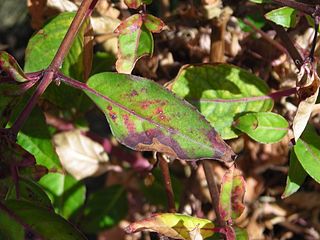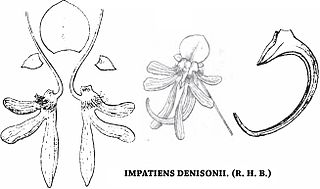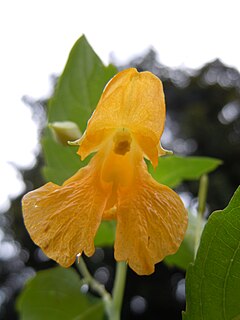
Impatiens is a genus of more than 1,000 species of flowering plants, widely distributed throughout the Northern Hemisphere and the tropics. Together with the genus Hydrocera, Impatiens make up the family Balsaminaceae.

Impatiens walleriana, also known as busy Lizzie, balsam, sultana, or simply impatiens, is a species of the genus Impatiens, native to eastern Africa from Kenya to Mozambique. The Latin specific epithet walleriana honours a British missionary, Horace Waller (1833–1896).

Impatiens glandulifera is a large annual plant native to the Himalayas. Via human introduction it is now present across much of the Northern Hemisphere and is considered an invasive species in many areas. Uprooting or cutting the plants is an effective means of control.

The Balsaminaceae are a family of dicotyledonous plants, comprising two genera: Impatiens, which consists of 1000+ species, and Hydrocera, consisting of 1 species. The flowering plants may be annual or perennial. They are found throughout temperate and tropical regions, primarily in Asia and Africa, but also North America and Europe.

Impatiens capensis, the orange jewelweed, common jewelweed, spotted jewelweed, or orange balsam, is an annual plant which is native to eastern North America. It is common in bottomland soils, ditches, and along creeks, often growing side-by-side with its less common relative, yellow jewelweed.

Impatiens balsamina, commonly known as balsam, garden balsam, rose balsam, touch-me-not or spotted snapweed, is a species of plant native to India and Myanmar.

Cardamine impatiens, the narrowleaf bittercress or narrow-leaved bitter-cress, is a plant species in the genus Cardamine of the family Brassicaceae. It is a slender, biennial herb, that produces sterile leaves in the first year, one to several flowering stems during the next. Its leaves are pinnate with several pairs of lanceolate, dentate leaflets and a terminal, slightly longer leaflet. The short petals surpass the calyx by half of its length. The seeds are arranged in one row on each side of the central membrane of the narrow pod and are ejected out in a shower due to the tension formed as the seed pod (silique) dries. It grows on walls, open ground in shady places in forests usually disturbed by man.

Impatiens necrotic spot orthotospovirus(INSV) is a plant pathogenic virus of the order Bunyavirales. It was originally believed to be another strain of Tomato spotted wilt virus but genetic investigations revealed them to be separate viruses. It is a single stranded RNA It has a tripartite genome and is largely spread by the insect vector of the western flower thrips. The virus infects more than 648 species of plant including important horticultural and agricultural species such as fuchsia, tomato, orchids, and lettuce. As the name implies, the main symptom on plants is necrotic spots that appear on the leaves. The INSV virus infects by injecting the RNA the virus contains into the cell which then starts using the cell resources to transcribe what the virus RNA states. Viral infection can often result in the death of the plant. The disease is mainly controlled by the elimination of the western flower thrip vector and by destroying any infected plant material.

Culiseta is a genus of mosquitoes. Most Culiseta species are cold-adapted, and only occur in warmer climates during the colder parts of the year or at higher elevations where temperatures are lower. Species found in Southern California are larger than most mosquitoes species, specifically Cs. inornata, Cs. particeps, and Cs. incidens. These species are found throughout the year in Southern California and feed on several vertebrate species, such as birds, livestock, rodents, reptiles, and humans. The larvae of most species are found bogs, marshes, ponds, streams, ditches, and rock pools, but an African species occurs in tree holes ("phytotelmata"), a common eastern Palaearctic species occurs in water wells and rock pools, and several Australian species occur under ground. Little is known about the blood-feeding habits of females. Most species feed on birds and mammals, but a few feed on reptiles. Several species attack domestic animals and occasionally humans, and some species are pollinators.

Impatiens balfourii is a species of the genus Impatiens known by the common names Balfour's touch-me-not, Kashmir balsam, and poor man's orchid. It belongs to the family Balsaminaceae.

Culiseta longiareolata is a species of mosquito.

Impatiens denisonii is a scapigerous herb species of the family Balsaminaceae, which is found only in the Western Ghats in South India. It is among the rarest of the eighteen Impatiens species which are endemic to the Nilgiri Hills. It was very abundant and considered among the most beautiful plants in the Nilgiri Hills.

Impatiens hawkeri, the New Guinea impatiens, is a species of flowering plant in the family Balsaminaceae. It is native to Papua New Guinea and the Solomon Islands. It has been bred and hybridized in cultivation to produce a line of garden plants.

Bombus impatiens, the common eastern bumble bee, is the most commonly encountered bumblebee across much of eastern North America. They can be found in the Eastern temperate forest region of the eastern United States, southern Canada, and the eastern Great Plains. Because of their great adaptability, they can live in country, suburbs, and even urban cities. This adaptability makes them a great pollinator species, leading to an increase in their commercial use by greenhouse industry. This increase consequently led to their farther spread outside their previous distribution range. They are considered one of the most important species of pollinator bees in North America.

Impatiens ecornuta, the spurless touch-me-not or western touch-me-not, is an annual flowering plant native to the northwestern United States and British Columbia in Canada.
Mordellina impatiens is a species of tumbling flower beetle in the family Mordellidae. It is found in North America.
Culiseta melanura, the black-tailed mosquito, is a species of mosquito in the family Culicidae. Since adult female Culiseta melanura primarily take their blood meals from birds, they are responsible for transmitting eastern equine encephalitis virus between birds. Humans, horses, and other mammals become infected with eastern equine encephalitis virus when other mosquito species besides Culiseta melanura, such as Aedes, Coquillettidia, and Culex species take blood meals first from infected birds and then later take blood meals from mammals, transferring the virus to these hosts.

Culiseta incidens, the cool weather mosquito, is a species of mosquito in the family Culicidae.

Culiseta inornata, the winter marsh mosquito, is a species of mosquito in the family Culicidae.
Culiseta minnesotae is a species of mosquito in the family Culicidae.
















